1993 CADILLAC FLEETWOOD brakes
[x] Cancel search: brakesPage 203 of 386
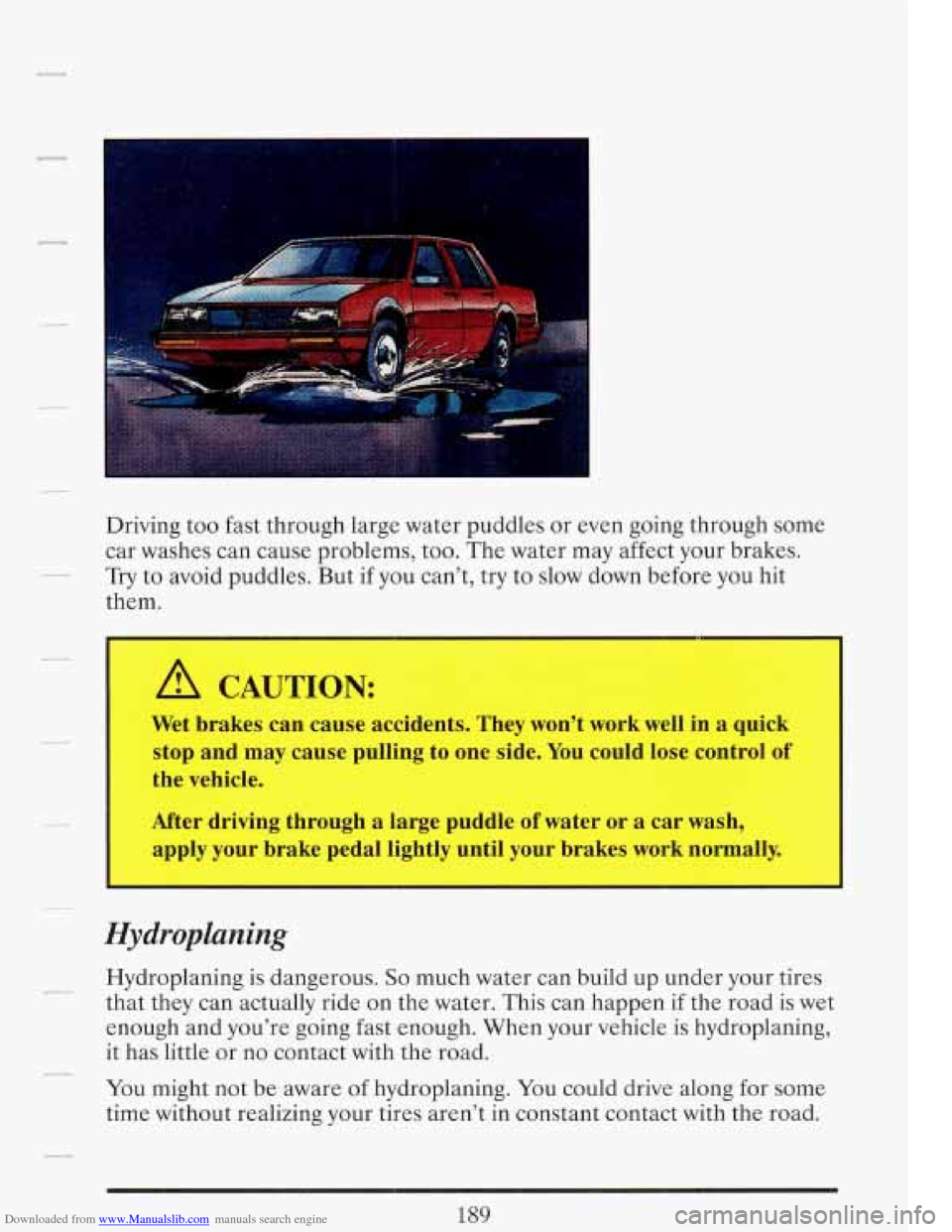
Downloaded from www.Manualslib.com manuals search engine Driving too fast through large water puddles or even going through some
car washes can cause problems, too. The water may affect your brakes.
them.
--- Try to avoid puddles. But if you can’t, try to slow down before you hit
-I
I A CAUTION:
Wet brakes can cause accidents. They won’t work well in a quick
I stop and may cause pulling to one side. You could lose control of
the vehicle.
I After driving through a large puddle of water or a car wash,
apply your brake pedal lightly until your brakes work normally.
Hydroplaning
- Hydroplaning is dangerous. So much water can build up under your tires
that they can actually ride on the water. This can happen
if the road is wet
enough and you’re going fast enough. When your vehicle is hydroplaning,
it has little or no contact with the road.
_I
You might not be aware of hydroplaning. You could drive along for some
time without realizing your tires aren’t in constant contact with the road.
189
Page 213 of 386
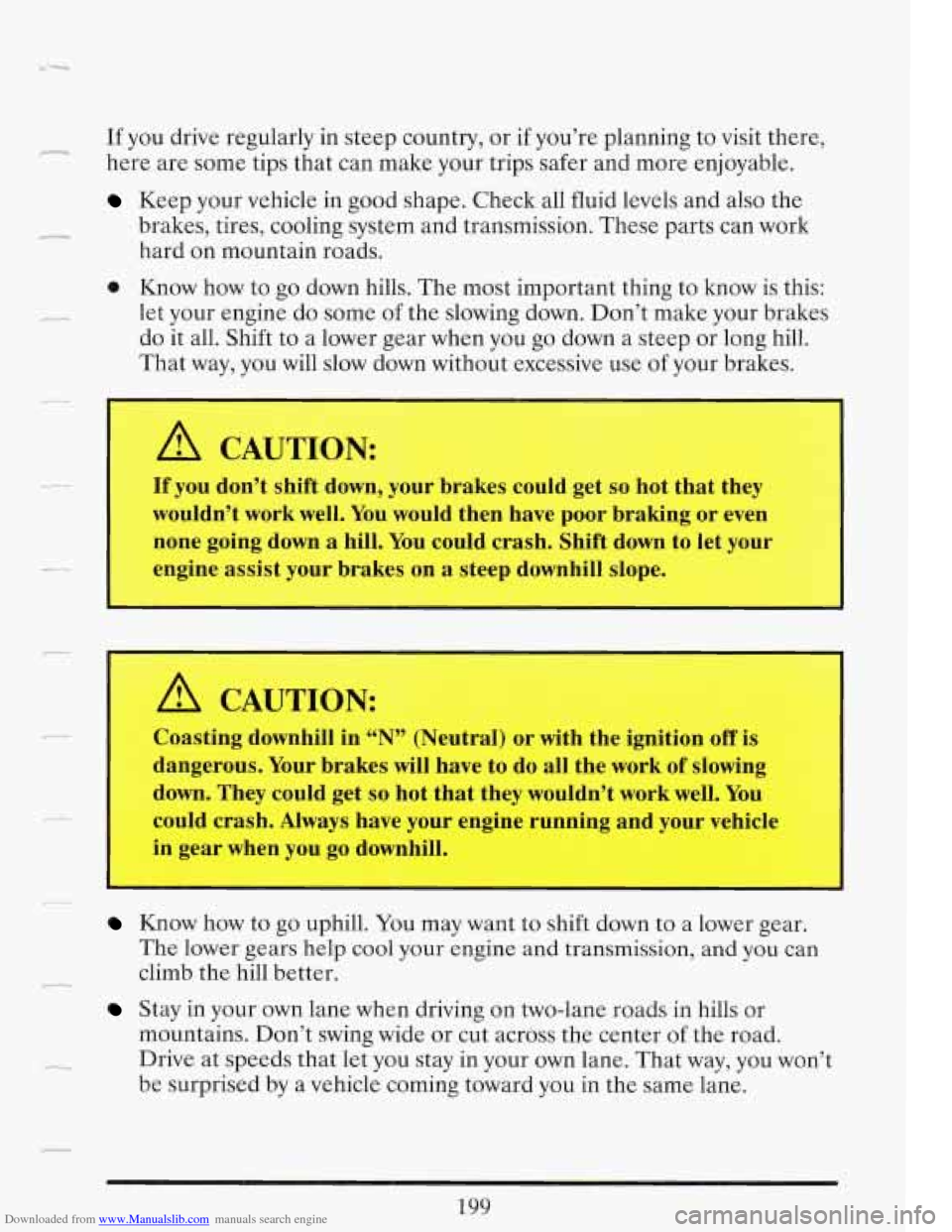
Downloaded from www.Manualslib.com manuals search engine c If you drive regularly in steep country, or if you’re planning to visit there,
here are some tips that can make your trips safer and more enjoyable.
Keep your vehicle in good shape. Check all fluid levels and also the
brakes, tires, cooling system and transmission. These parts can work
hard on mountain roads.
0 Know how to go down hills. The most important thing to know is this:
let your engine do some
of the slowing down. Don’t make your brakes
do it all. Shift to a lower gear when you go down a steep or long hill.
That way, you will slow down without excessive use
of your brakes.
I_ I
I
I A CAUTION:
If you don’t shift down, your brakes could get so hot that they
wouldn’t work well. You would then have poor braking or even
none going down a hill. You could crash. Shift down to let your
engine assist your brakes on
a steep downhill slope.
I
A CAUTION:
- I Coasting downhill in “N” (Neutral) or with the ignition off is
dangerous. Your brakes
will have to do all the work of slowing
down. They could get
so hot that they wouldn’t work well. You
could crash. Always have your engine running and your vehicle
in gear when you go downhill.
I
Know how to go uphill. You may want to shift down to a lower gear.
The lower gears help cool your engine and transmission, and you can
e.-- climb the hill better.
,-
Stay in your own lane when driving on two-lane roads in hills or
mountains. Don’t swing wide or cut across the center of the road.
Drive at speeds that let you stay in your own lane. That way, you won’t
be surprised by a vehicle coming toward you in the same lane.
Page 219 of 386
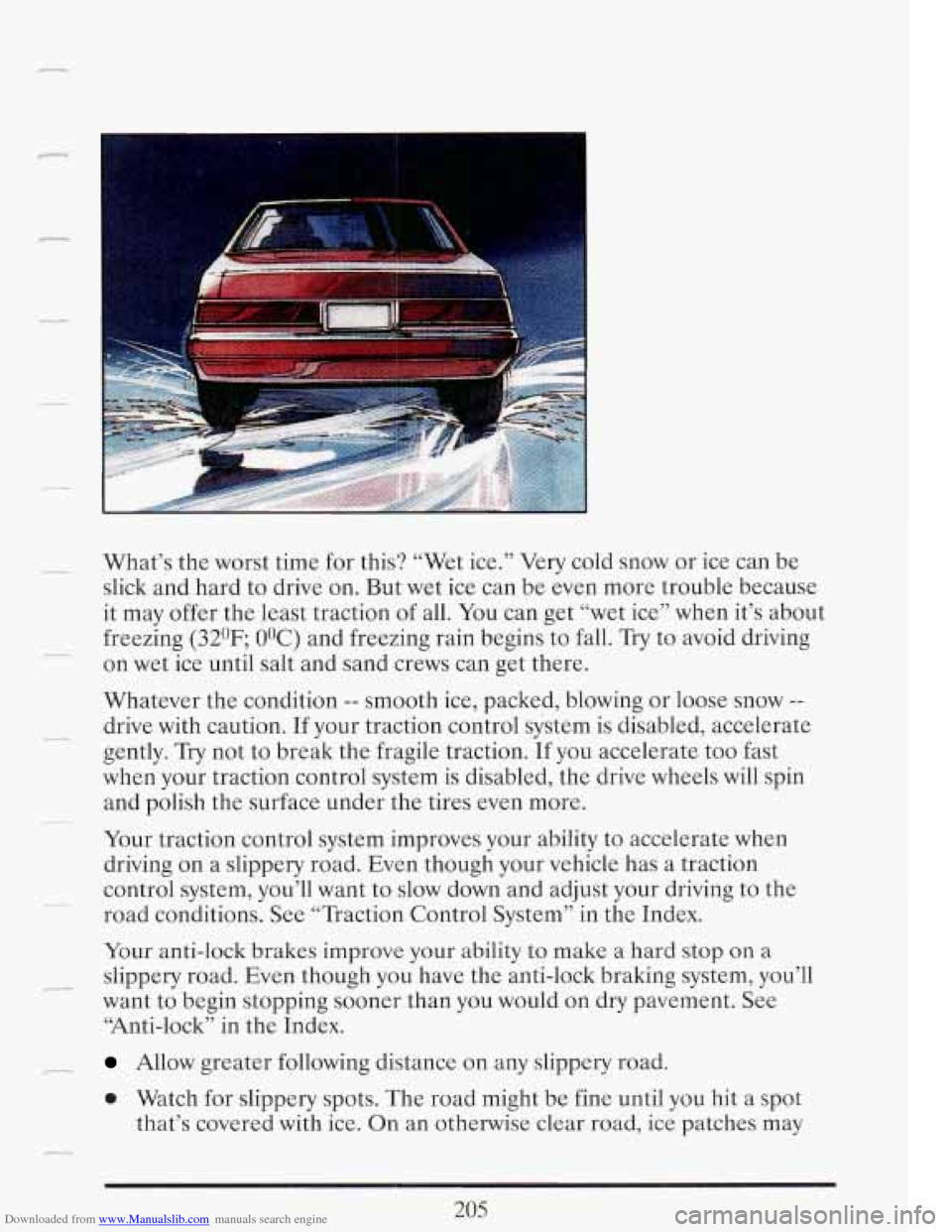
Downloaded from www.Manualslib.com manuals search engine I
- What’s the worst time for this? “Wet ice.” Very cold snow or ice can be
slick and hard to drive on. But wet ice can be even more trouble because
it may offer the least traction
of all. You can get “wet ice’’ when it’s about
freezing
(320F; OOC) and freezing rain begins to fall. Try to avoid driving
on wet ice until salt and sand crews can get there. -
Whatever the condition -- smooth ice, packed, blowing or loose snow --
- drive with caution. If your traction control system is disabled, accelerate
gently.
Try not to break the fragile traction. If you accelerate too fast
when your traction control system is disabled, the drive wheels will spin
and polish the surface under the tires even more.
Your traction control system improves your ability to accelerate
when
driving on a slippery road. Even though your vehicle has a traction
control system, you’ll want to slow down and adjust your driving to the
road conditions. See “Traction Control System” in the Index.
-
-
Your anti-lock brakes improve your ability to make a hard stop on a
want to begin stopping sooner than you would on dry pavement. See
“Anti-lock’’ in the Index.
7 slippery road. Even though you have the anti-lock braking system, you’ll
T Allow greater following distance on any slippery road.
e Watch for slippery spots. The road might be fine until you hit a spot
that’s covered with ice. On an otherwise clear road, ice patches may
Page 222 of 386
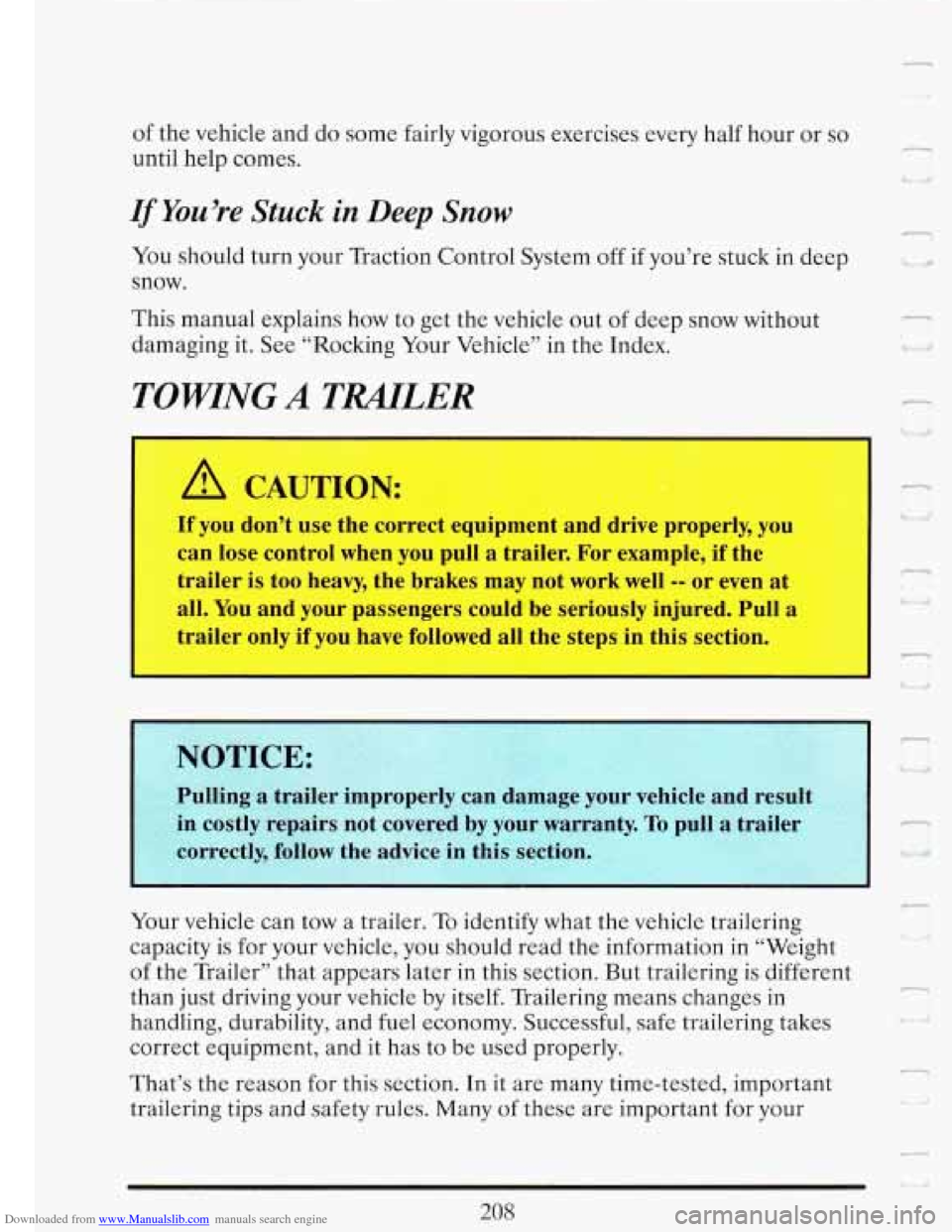
Downloaded from www.Manualslib.com manuals search engine of the vehicle and do some fairly vigorous exercises every half hour or so
until help comes.
If You’re Stuck in Deep Snow
You should turn your Traction Control System off if you’re stuck in deep
snow.
This manual explains how
to get the vehicle out of deep snow without
damaging it. See “Rocking Your Vehicle” in the Index.
TOWING A TMLER
A CAUTION:
If you don’t use the correct equipment and drive properly, you
can lose control when you pull a trailer. For example, if the
trailer is too heavy, the brakes may not work well
-- or even at
all.
You and your passengers could be seriously injured. Pull a
trailer only if you have followed all the steps in this section.
I
~~ ~ ~~ id
7
\. i
Pulling a trailer improperly can damage your vehicle and result
in costly repairs not covered by your warranty.
To pull a trailer -
c*
Your vehicle can tow a trailer. To identify what the vehicle trailering ;
capacity is for your vehicle, you should read the information in “Weight
of the Trailer” that appears later in this section. But trailering is different
than just driving your vehicle by itself. Trailering means changes in
handling, durability, and fuel economy. Successful, safe trailering takes
correct equipment, and it has to be used properly.
-
That’s the reason for this section. In it are many time-tested, important
trailering tips and safety rules. Many of these are important for your m .> d
c-
.J ~
208
Page 226 of 386
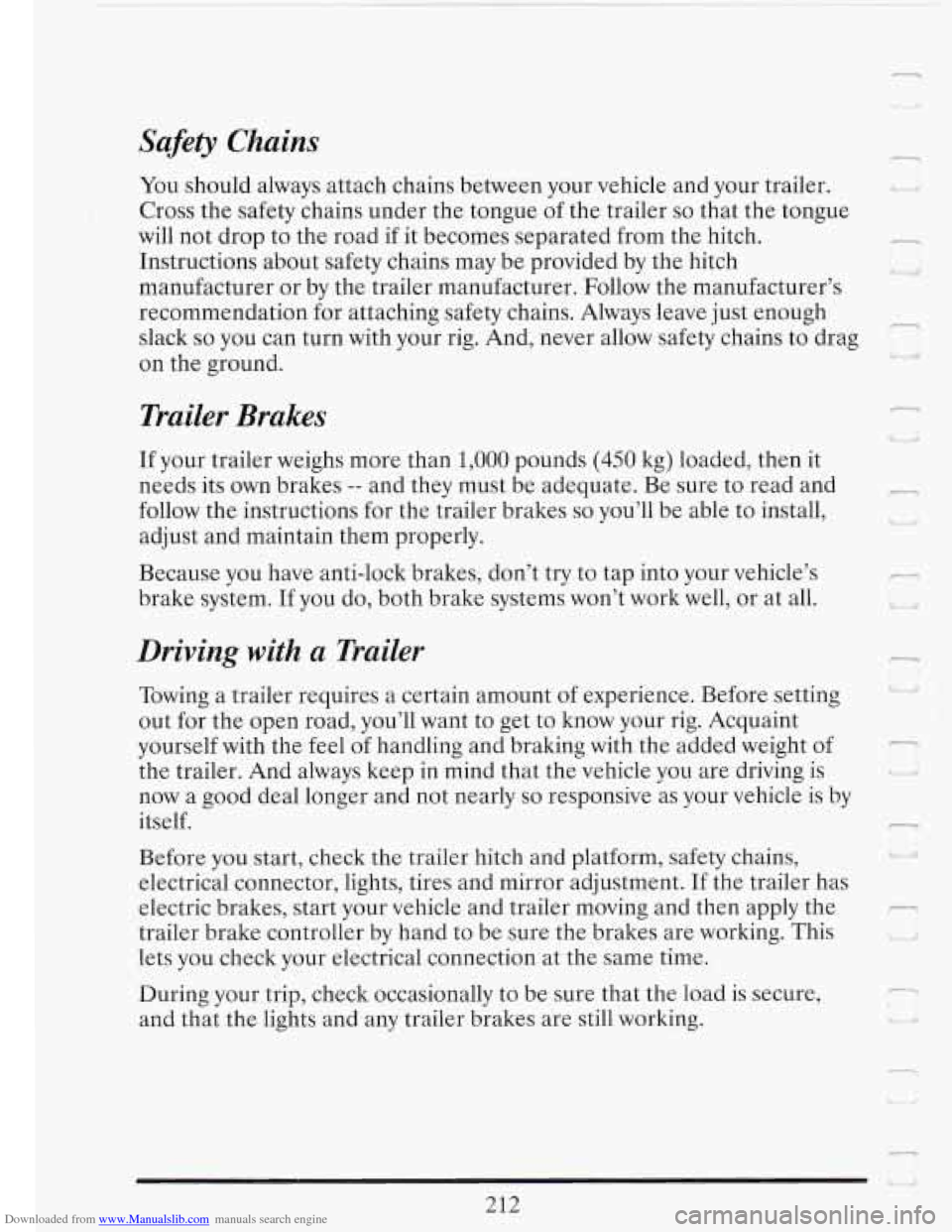
Downloaded from www.Manualslib.com manuals search engine Safety Chains
You should always attach chains between your vehicle and your trailer.
Cross the safety chains under the tongue
of the trailer so that the tongue
will not drop to the road if it becomes separated from the hitch.
Instructions about safety chains may be provided by the hitch
manufacturer or by the trailer manufacturer. Follow the manufacturer’s
recommendation for attaching safety chains. Always leave just enough
slack
so you can turn with your rig. And, never allow safety chains to drag
on the ground.
-
,-
Trailer Brakes
If your trailer weighs more than 1,000 pounds (450 kg) loaded, then it
needs its
own brakes -- and they must be adequate. Be sure to read and
follow the instructions for the trailer brakes
so you’ll be able to install,
adjust and maintain them properly.
Because
you have anti-lock brakes, don’t try to tap into your vehicle’s
brake system. If you do, both brake systems won’t work well, or at all.
Driving with a Trailer
Towing a trailer requires a certain amount of experience. Before setting
out for the open road, you’ll want to get to know your rig. Acquaint
yourself with the feel of handling and braking with the added weight of
the trailer. And always keep
in mind that the vehicle you are driving is
now a good deal longer and not nearly
so responsive as your vehicle is by
itself.
-
Before you start, check the trailer hitch and platform, safety chains, ..
electrical connector, lights, tires and mirror adjustment. If the trailer has
electric brakes, start your vehicle and trailer moving and then apply the
trailer brake controller by hand to be sure the brakes are working. This
lets you check your electrical connection at the same time.
During your trip, check occasionally to be sure that the load
is secure,
and that the lights and any trailer brakes are still working.
212
Page 228 of 386
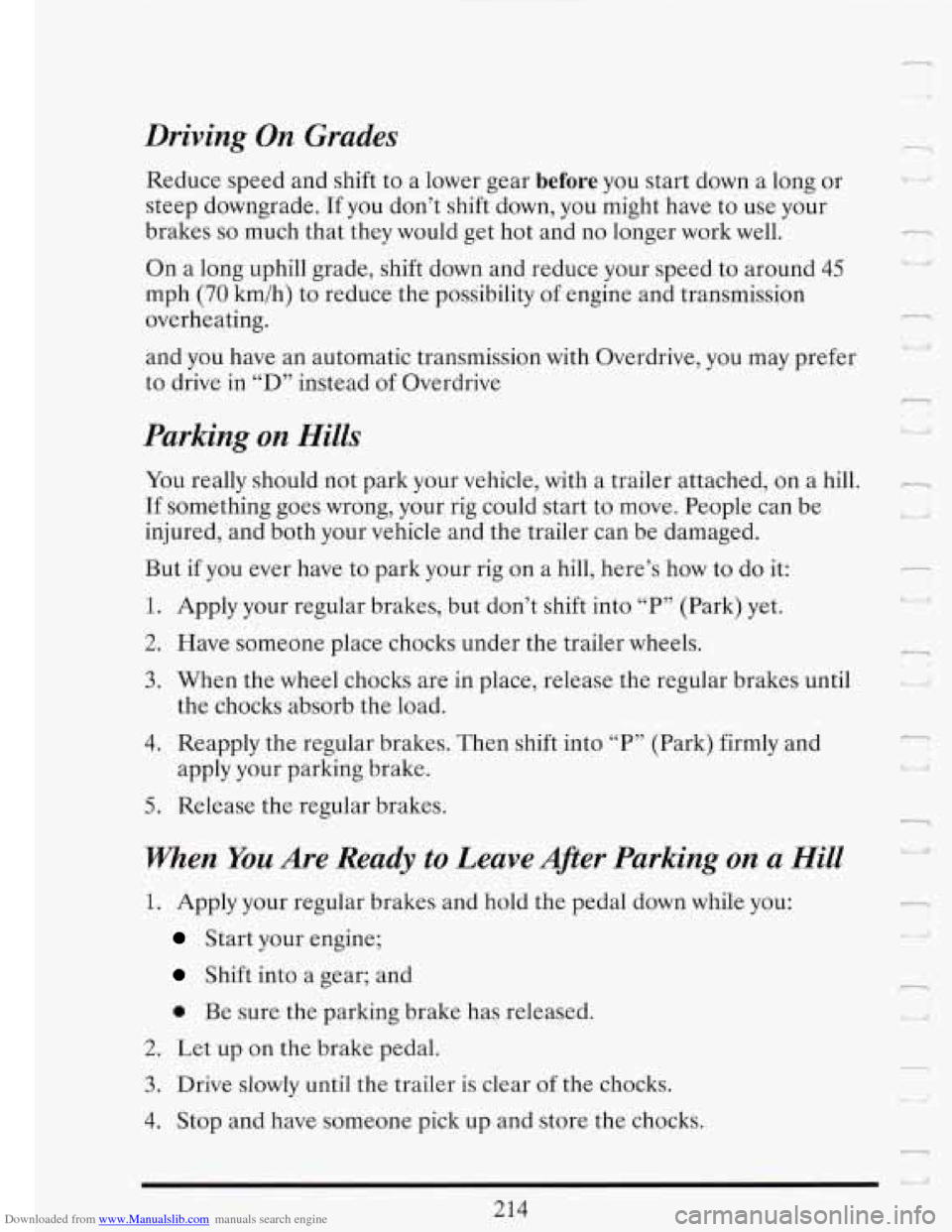
Downloaded from www.Manualslib.com manuals search engine Driving On Grades
Reduce speed and shift to a lower gear before you start down a long or
steep downgrade. If you don’t shift down, you might have to use your
brakes
so much that they would get hot and no longer work well.
On a long uphill grade, shift down and reduce your speed to around 45
mph (70 kmih) to reduce the possibility of engine and transmission
overheating.
19 1
d l
n 1, ia
and you have an automatic transmission with Overdrive, you may prefer
to drive in
“D” instead of Overdrive
Parking on Hills
You really should not park your vehicle, with a trailer attached, on a hill. -
If something goes wrong, your rig could start to move. People can be
injured, and both your vehicle and the trailer can be damaged. <-
But if you ever have to park your rig on a hill, here’s how to do it:
1. Apply your regular brakes, but don’t shift into “P” (Park) yet.
2. Have someone place chocks under the trailer wheels.
3. When the wheel chocks are in place, release the regular brakes until
4. Reapply the regular brakes. Then shift into “P” (Park) firmly and
apply your parking brake.
5. Release the regular brakes.
the
chocks absorb the load.
When You Are Ready to Leave After Parking on a Hill
1. Apply your regular brakes and hold the pedal down while you:
Start your engine;
Shift into a gear; and
0 Be sure the parking brake has released.
2. Let up on the brake pedal.
3. Drive slowly until the trailer is clear of the chocks.
4.
Stop and have someone pick up and store the chocks.
r .t
-1
L
e_i
u
,. .
214
Page 289 of 386
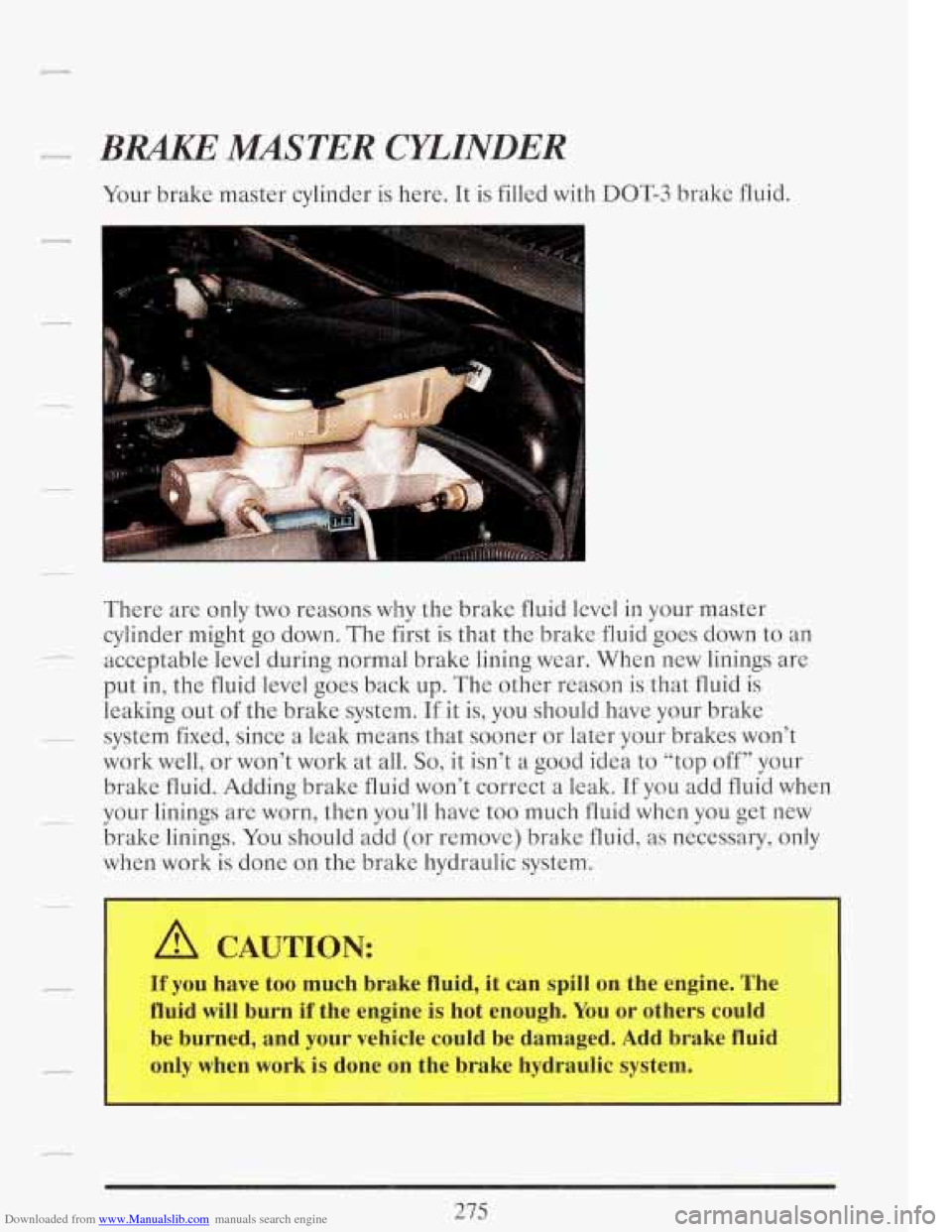
Downloaded from www.Manualslib.com manuals search engine There are only two reasons why the brake fluid level in your master
cylinder might go down. The first is that the brake fluid goes down to an
put in, the fluid
level goes back up. The other reason is that fluid is
leaking out
of the brake system. If it is, you should have your brake
work well, or won’t work at all.
So, it isn’t a good idea to “top off” your
brake fluid. Adding brake fluid won’t correct
a leak. If you add fluid when
__ your linings are worn, then you’ll have too much fluid when you get new
brake linings. You should add (or remove) brake fluid,
as necessary, only
when work is done on the brake hydraulic system.
-- acceptable level during normal brake lining wear. When new linings are
~ system fixed, since a leak means that sooner or later your brakes won’t
A CAUTION:
If you have too much brake fluid, it can spill on the engine. The
fluid
will burn if the engine is hot enough. You or others could
be burned, and your vehicle could be damaged. Add brake fluid
only when work is done on the brake hydraulic system.
275
Page 291 of 386
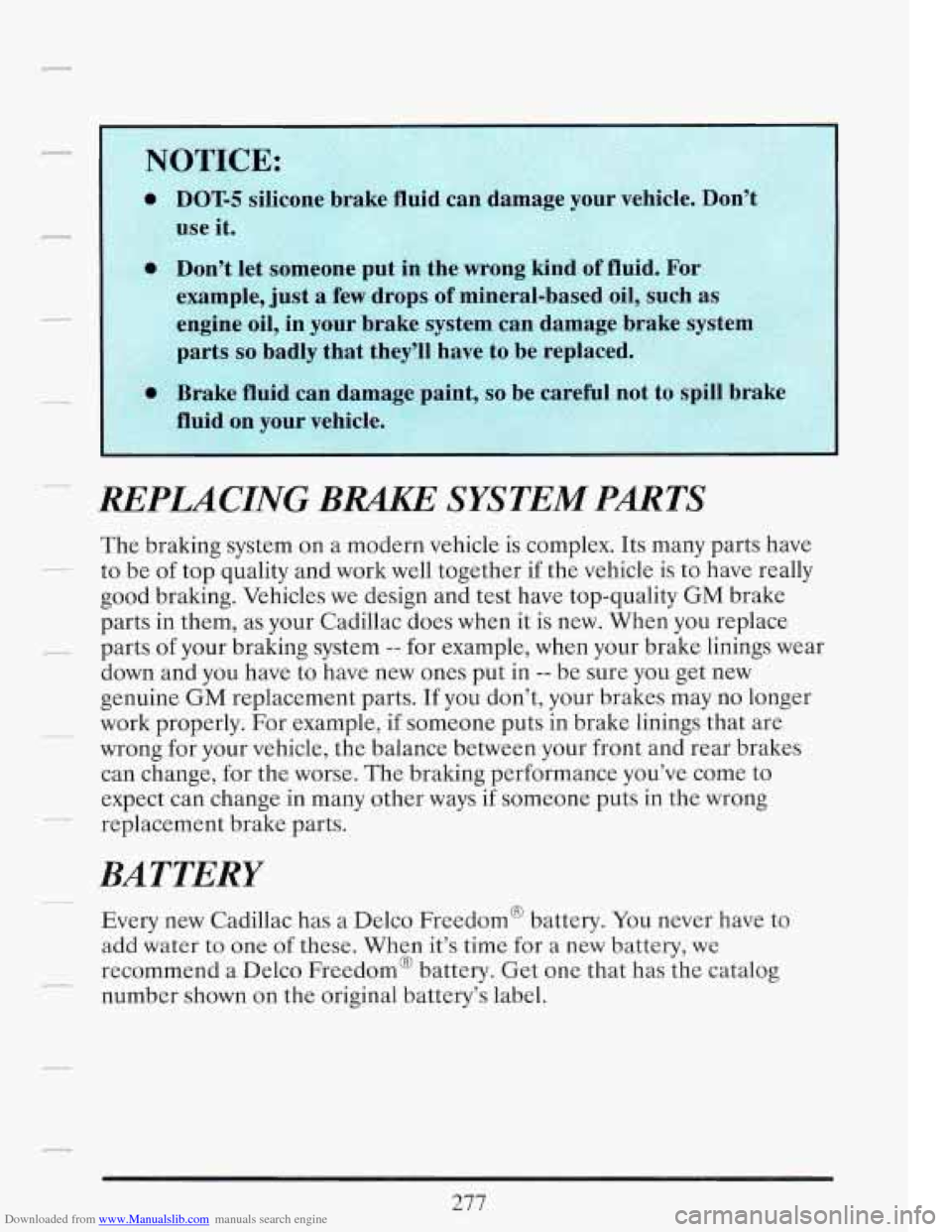
Downloaded from www.Manualslib.com manuals search engine REPLACING BRAKE SYSTEM PARTS
The braking system on a modern vehicle is complex. Its many parts have
to be of top quality and work well together if the vehicle is to have really
good braking. Vehicles we design and test have top-quality GM brake
parts in them, as your Cadillac does when it
is new. When you replace
parts of your braking system
-- for example, when your brake linings wear
down and you have to have new ones put in
-- be sure you get new
genuine
GM replacement parts. If you don’t, your brakes may no longer
work properly. For example, if someone puts in brake linings that are
wrong for your vehicle, the balance between your front and rear brakes
can change, for the worse. The braking performance you’ve come to
expect can change in many other ways if someone puts
in the wrong
replacement brake parts.
BATTERY
Every new Cadillac has a Delco Freedom’ battery. You never have to
add water to one of these. When it’s time for
a new battery, we
recommend a Delco Freedom@ battery. Get one that has the catalog
number shown
on the original battery’s label.
277